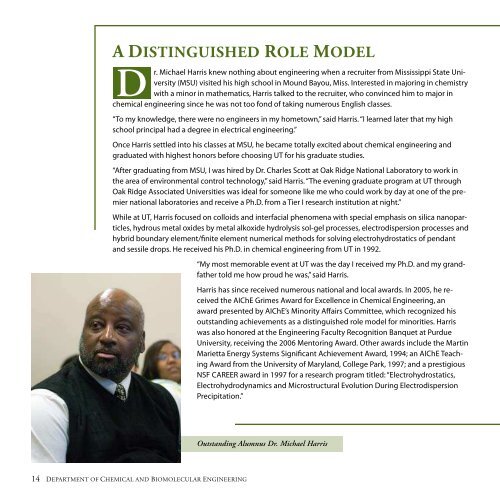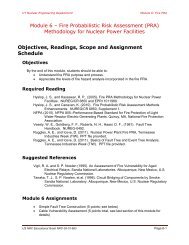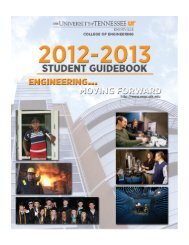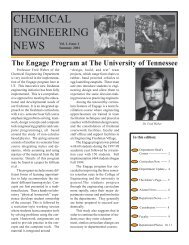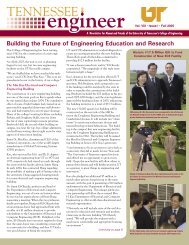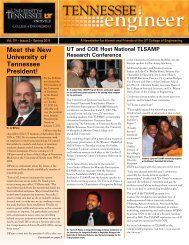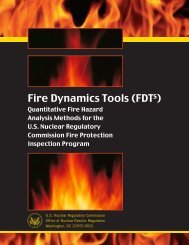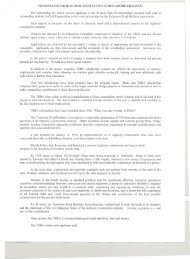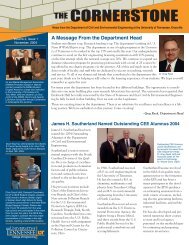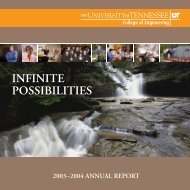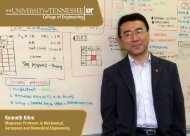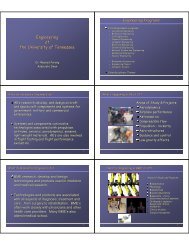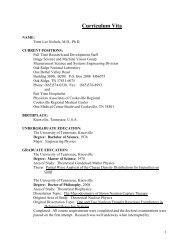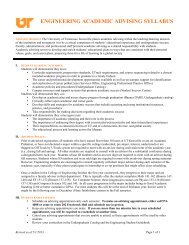CBE 2007 Annual Report - College of Engineering - The University ...
CBE 2007 Annual Report - College of Engineering - The University ...
CBE 2007 Annual Report - College of Engineering - The University ...
Create successful ePaper yourself
Turn your PDF publications into a flip-book with our unique Google optimized e-Paper software.
A DISTINGUISHED ROLE MODEL<br />
D<br />
r. Michael Harris knew nothing about engineering when a recruiter from Mississippi State <strong>University</strong><br />
(MSU) visited his high school in Mound Bayou, Miss. Interested in majoring in chemistry<br />
with a minor in mathematics, Harris talked to the recruiter, who convinced him to major in<br />
chemical engineering since he was not too fond <strong>of</strong> taking numerous English classes.<br />
“To my knowledge, there were no engineers in my hometown,” said Harris. “I learned later that my high<br />
school principal had a degree in electrical engineering.”<br />
Once Harris settled into his classes at MSU, he became totally excited about chemical engineering and<br />
graduated with highest honors before choosing UT for his graduate studies.<br />
“After graduating from MSU, I was hired by Dr. Charles Scott at Oak Ridge National Laboratory to work in<br />
the area <strong>of</strong> environmental control technology,” said Harris. “<strong>The</strong> evening graduate program at UT through<br />
Oak Ridge Associated Universities was ideal for someone like me who could work by day at one <strong>of</strong> the premier<br />
national laboratories and receive a Ph.D. from a Tier I research institution at night.”<br />
While at UT, Harris focused on colloids and interfacial phenomena with special emphasis on silica nanoparticles,<br />
hydrous metal oxides by metal alkoxide hydrolysis sol-gel processes, electrodispersion processes and<br />
hybrid boundary element/finite element numerical methods for solving electrohydrostatics <strong>of</strong> pendant<br />
and sessile drops. He received his Ph.D. in chemical engineering from UT in 1992.<br />
“My most memorable event at UT was the day I received my Ph.D. and my grandfather<br />
told me how proud he was,” said Harris.<br />
Harris has since received numerous national and local awards. In 2005, he received<br />
the AIChE Grimes Award for Excellence in Chemical <strong>Engineering</strong>, an<br />
award presented by AIChE’s Minority Affairs Committee, which recognized his<br />
outstanding achievements as a distinguished role model for minorities. Harris<br />
was also honored at the <strong>Engineering</strong> Faculty Recognition Banquet at Purdue<br />
<strong>University</strong>, receiving the 2006 Mentoring Award. Other awards include the Martin<br />
Marietta Energy Systems Significant Achievement Award, 1994; an AIChE Teaching<br />
Award from the <strong>University</strong> <strong>of</strong> Maryland, <strong>College</strong> Park, 1997; and a prestigious<br />
NSF CAREER award in 1997 for a research program titled: “Electrohydrostatics,<br />
Electrohydrodynamics and Microstructural Evolution During Electrodispersion<br />
Precipitation.”<br />
Outstanding Alumnus Dr. Michael Harris<br />
“For over a decade, Harris has excelled as an effective teacher,<br />
researcher and administrator,” said Dr. Brian Edwards, associate<br />
pr<strong>of</strong>essor and associate head <strong>of</strong> the Department <strong>of</strong><br />
Chemical and Biomolecular <strong>Engineering</strong> at UT. “His national<br />
recognition as a progressive, distinguished role model for<br />
minorities through the American Institute <strong>of</strong> Chemical<br />
Engineers 2005 Grimes Award for Excellence in Chemical<br />
<strong>Engineering</strong> is one reason our department is proud to call<br />
him an alumni.”<br />
Harris’s current research interests include biotemplated<br />
synthesis <strong>of</strong> nanowires and nanometric metal particles for<br />
sensor applications; use <strong>of</strong> electrodispersion processes for<br />
the synthesis <strong>of</strong> calcium alginate microspheres for the controlled-release<br />
<strong>of</strong> drugs; theory and experiment <strong>of</strong> external<br />
field effects on particle deposition from an evaporating<br />
drop; electrohydrodynamics <strong>of</strong> free, pendant and sessile<br />
drops; and theory and experiment <strong>of</strong> electrokinetics in porous<br />
media.<br />
Because <strong>of</strong> his desire to recruit and graduate students, Harris<br />
chose to teach and is currently a pr<strong>of</strong>essor <strong>of</strong> chemical<br />
engineering and associate dean for undergraduate education<br />
at Purdue <strong>University</strong>.<br />
“Teaching gives me the opportunity to accomplish my<br />
goals to attract more female and minority students to engineering,”<br />
said Harris. “I like to encourage students who have<br />
great potential, but who lack confidence to excel in engineering.<br />
My greatest joy is to receive letters from students<br />
thanking me for encouraging them and challenging them<br />
to perform well in their engineering studies, and for encouraging<br />
them to go to graduate school.”<br />
Renowned Lecturers Discuss<br />
Intriguing <strong>Engineering</strong> Issues<br />
<strong>The</strong> <strong>CBE</strong> department hosted two distinguished lecture series<br />
this year.<br />
Pr<strong>of</strong>essor Robert C. Armstrong, Chevron<br />
Pr<strong>of</strong>essor and Chemical <strong>Engineering</strong> Department<br />
Head at the Massachusetts Institute<br />
<strong>of</strong> Technology (MIT) presented “<strong>The</strong> Global<br />
Energy Challenge and MIT’s Response” February<br />
6, <strong>2007</strong>, in the Science and <strong>Engineering</strong><br />
Research Facility on the UT campus.<br />
Armstrong addressed concerns about sustainable energy<br />
sources that will meet demands for quality <strong>of</strong> life and economic<br />
growth in both the developed and developing worlds.<br />
He illustrated MIT’s response to these challenges.<br />
Dr. James C. Liao was the special guest for<br />
the department’s annual Troy C. Trotter Distinguished<br />
Lecture Series in Chemical <strong>Engineering</strong>.<br />
A pioneer in the fields <strong>of</strong> metabolic<br />
engineering, synthetic biology and systems<br />
biology, Liao is currently serving as the Vice<br />
Chair <strong>of</strong> the Chemical and Biomolecular <strong>Engineering</strong> Department<br />
at the <strong>University</strong> <strong>of</strong> California, Los Angeles.<br />
Liao’s topic was “Synthetic Biological Circuits,” and his presentation<br />
involved a discussion <strong>of</strong> design approaches to engineer<br />
cellular networks at both genetic and metabolic levels.<br />
<strong>The</strong> Troy C. Trotter Distinguished Lecture Series was established<br />
by the Trotter family to provide the <strong>CBE</strong> department<br />
with opportunities to invite nationally recognized experts in<br />
areas <strong>of</strong> interest to the field <strong>of</strong> chemical engineering to the<br />
<strong>University</strong> <strong>of</strong> Tennessee, Knoxville for the benefit <strong>of</strong> students,<br />
faculty and the local pr<strong>of</strong>essional community. <strong>The</strong> series<br />
recognizes and honors Troy C. Trotter, who received a B.S. in<br />
chemical engineering from UT in 1947. Trotter retired as Director<br />
<strong>of</strong> Project Site <strong>Engineering</strong> for Y-12, K-25 and Oak Ridge<br />
National Laboratory (ORNL) in 1986.<br />
14 DEPARTMENT OF CHEMICAL AND BIOMOLECULAR ENGINEERING <strong>2007</strong> ANNUAL REPORT 15


